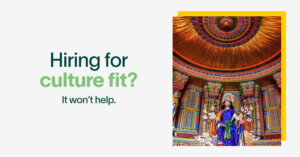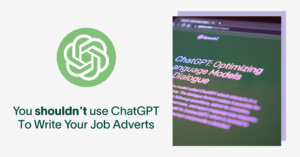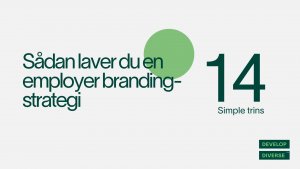When you’re looking for a new hire, your employer branding can play a huge role in whether a candidate decides to apply for your role or not. So naturally, that makes it critical for you to show your organisation at its very best.
It’s your unique selling points, your secret sauce — it’s what makes your organisation great. It’s what differentiates your organisation from your competitors. And it’s all in the language you use, and the words you choose to drive excitement that candidates will want to join your rocket ship organisation.
But as organisations face increasing demands to make their recruitment practices more inclusive, it’s sparked a very real fear that switching things up for a more inclusive tone on their job adverts might make their employer branding sound a little… samey.
Amalie Dunkerley, Research Specialist here at Develop Diverse, explains why that’s not the case, and why inclusive language is actually better for your employer branding.
Non-inclusive language makes your organisation blend in
Job advert buzzwords and jargon have become part of the furniture of job adverts over the last decade. Every organisation wants a candidate who is ambitious, driven, and will thrive in a fast-paced environment. And while these might sound like they elevate your organisation’s employer branding, they’re actually more likely to harm your candidate’s perception of how inclusive your company is.
This common adopted language might be making lots of organisations sound the same, too.
“If we consider trends in job adverts right now, we already see a lot of companies consistently using the same words,” Amalie says. “Increasingly, organisations have adopted phrases like ‘drive’, ‘ambitious’, and talking about ‘dynamic’ environments as part of how they market a role to candidates. But from research, we know that these words contain stereotypes and bias that can be perceived negatively by candidates from different identity groups — and often, organisations aren’t always clear on what they mean when they use them.”
Research shows that young jobseekers may be discouraged from applying to a role when a job advert contains business buzzwords or jargon. Linguistic ambiguity in the job advert means neurodivergent candidates often self-select out of applying for roles.
“When candidates see non-inclusive words in a job advert, it could be communicating something unintended about your organisation,” Amalie says. “But if your organisation uses non-inclusive words that feel integral to your brand identity, then this may signal that there are unintentional unconscious biases in the branding you’ve created. In reality, your organisation could be the best place to work — but you might not be communicating that in your language choices.”
Inclusive language will always make your employer branding more accessible, meaning you’re more likely to attract a wider candidate pool. The key to getting it right is making simple inclusive switches that get you even closer to your brand identity.
Where does targeted language show up?
In a typical job advert, targeted language can be found in the desired traits of your candidate, the role description, responsibilities, and the words you choose to describe your culture or organisation.
Many of these language choices can happen at an unconscious level — especially if they’re reinforced by a mental picture of who the ‘ideal’ candidate is. In a job advert for a nurse, for example, societal biases mean we’re more likely to picture a woman.
This means that whether you’re discussing your mission-driven culture or your free childcare facilities, you need to be conscious as to how all the words you choose to describe a role may communicate implicit stereotypes or bias. You also need to consider how they might be interpreted by members of different identity groups.
If you’re hiring for both a product manager and an executive assistant for example, you’ll want to make sure you don’t only mention your free childcare facilities in the job advert for the executive assistant.
Targeted language can also show up in more explicit ways, like your organisation’s diversity statement, or explicit statements on your recruitment page that relate to your employer branding.
“Research shows that when we’re looking at explicitly targeted language, like employer equal opportunity statements, they can have a very varied effect on different groups. For example, one study found that Black people were actually discouraged from applying to organisations after reading their equal opportunity statement, because they felt like they would be hired for tokenistic reasons, rather than based on their own merit.”
What is the impact of targeted language?
While creating job adverts targeted towards specific groups of people might seem like a no-brainer when trying to increase your organisation’s level of diversity, it actually can have a huge impact on not only who applies to the role, but a number of important outcomes downstream, too.
“It can change almost everything from who is invited to the interview, to how people are interviewed, and who gets the role,” Emil explains. “Before people even apply to the role, you’ve already primed yourself that you’ll hire a certain type of candidate. So if you’ve written a job advert that’s consciously or unconsciously targeting women for a role, you’re already starting your hiring process based on a stereotype of what you expect to see.
“But if the woman you interview does not match that stereotype — maybe she is focused on career advancement, for example — then you’re more likely to evaluate them negatively because they don’t fit into your unconscious selection process.”
It goes deeper than just who ends up in the interview room. Using targeted language in a job advert means you’re also less likely to be objective on the questions you ask, and how you score the candidate’s suitability. Ultimately, that changes who gets the job.
Eliminate targeted language, increase the diversity of your candidate pool
Building more diverse and inclusive organisations may start with language. But it doesn’t start with using language to target the types of people we want to see in our organisations in the future.
Instead, it starts with increasing the inclusivity of how we communicate. Research consistently shows that inclusive language benefits everyone — so when you’re able to identify and eliminate unconscious bias and stereotypes in your written communication, it means you can start building a company where everyone feels they can belong.
Develop Diverse is an inclusive communication platform that can help you get started on this journey. Our research-backed tool leverages AI and machine learning to help you identify biased language in your job adverts and beyond, suggesting the alternatives that build an inclusive employer brand and more diverse organisation. Book a demo with one of our team members today.





